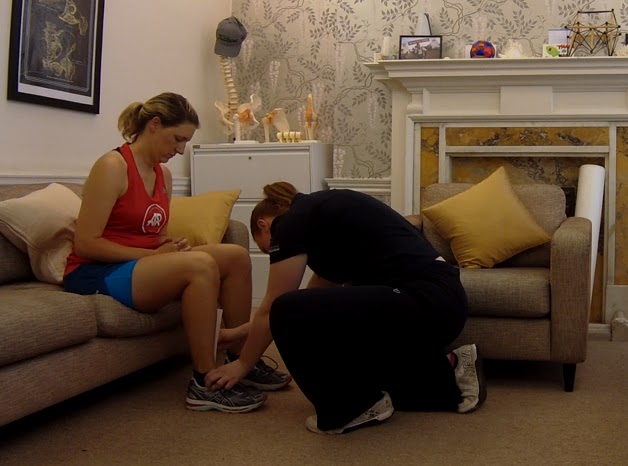A few weeks ago, dorsaVi got in touch and offered me a chance to have my running form analysed. Having had a gait analysis done before, I was keen to see what this process would offer me in terms of information (and of course, if I am any better at running now after having started corrective exercise training).
The only place in London to offer this service is the Bowskill Clinic near Baker Street/Oxford Street tube station. The team there welcomed me warmly, even though I was a sweaty mess and 10 minutes late (I seriously need a proper compass). I met Rachel and Jon, who kindly brought me up to one of the posh exam rooms and explained the technology to me. In simplest terms, the ViMove2 are two little sensors that are taped to your tibia on each leg.
 |
| Rachel taking measurements to ensure the sensors were positioned properly. |
This wearable technology monitors your motion and muscle activity in real time. Originally, the clinic used dorsaVi sensors for patients with back injuries. Clients would be sent home with the sensors attached for 24 hours and then return for the data upload and report. The ViMove2, however, is for analyzing knee movements. These can also be worn home for a long period of time but with a short assessment you can still obtain a lot of information.
After my online profile was created and the sensors attached, the testing phase of my appointment lasted about 15 minutes. First, I had to perform squats. Each movement I did three or four times to provide an average score. Next, I had to squat on just my left leg, then just the right. Finally, I had to hop on each foot. We then headed outside for a three minute jog in a nearby park. It was really sunny and warm on the day of my appointment so I got a bit sweaty.
 |
| I am taking this test very seriously. |
I am happy to say the sensors stayed in place with the adhesive tape used. I could barely notice they were there so I don’t think my running form was comprised at all. By running for at least three minutes, the data collected can look at my running rhythm and stride patterns over time.
| Just before my run. I had shorts on, I swear! |
After all the info is downloaded to the software, a large report is generated. By taking measurements of the angle off of the centre (your neutral position), it can let you know how symmetrical your legs are, if your legs rotate in or out when you move (which could lead to pain or injury). The tibial inclination (TI) is the maximum angle that the tibia tilt forward while your foot is on the ground. A TI of less than 20 can indicate poor ankle movement and/or reduced leg strength. I am not yet at 20, but pretty close. My right Achilles was bothering me this day, to the point that even Jon noticed the difference in my left and right leg jumps just by observing how high I jumped.
 |
| Valgus and varus details for each test |
 |
| Information is also shown in 2D. This is for two repetitions of a squat. |
The data collected during the run also tells you your ground contact time, initial peak acceleration, and ground force reaction. Using this info, along with other baseline tests, sports therapists and trainers can develop a training program to correct any issues. At a later date, you can then re-test and see if there have been improvements. Here is some of my data:
- Ground contact time was high, indicating low cadence and possible fatigue.
- Initial peak acceleration was average.
- Ground force reaction was very low, which may indicate run efficiency.
- My cadence was 173/min at a 12 km/hour pace.
 |
| Data from my three minute run |
As a biologist-by-training, I much prefer data-driven evidence. It makes more sense to me and can be confidently monitored over time. Even having something as simple as photographs or videos of your form can be a powerful tool. I look forward to seeing how wearable technology makes it easier for athletes, either professionals or amateurs, to improve their performance. The ViMove2 was a very simple physical performance-based test, non-invasive, and provided a lot of information. If you are looking to improve your run form, see how your body moves in different kit (such as shoes), or want to learn more about how your body moves, I highly recommend finding a local provider who offers ViMove2 sessions.
Thanks to the Bowskill Clinic and dorsiVi for the complimentary experience in trying out this movement monitoring system. All opinions are honest and my own. The crappy running form too.
